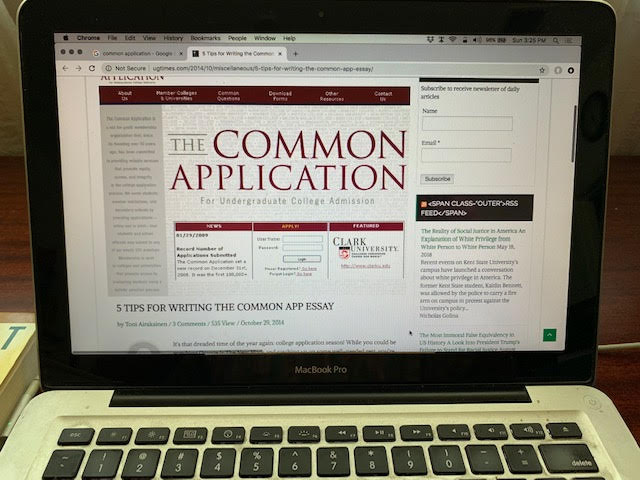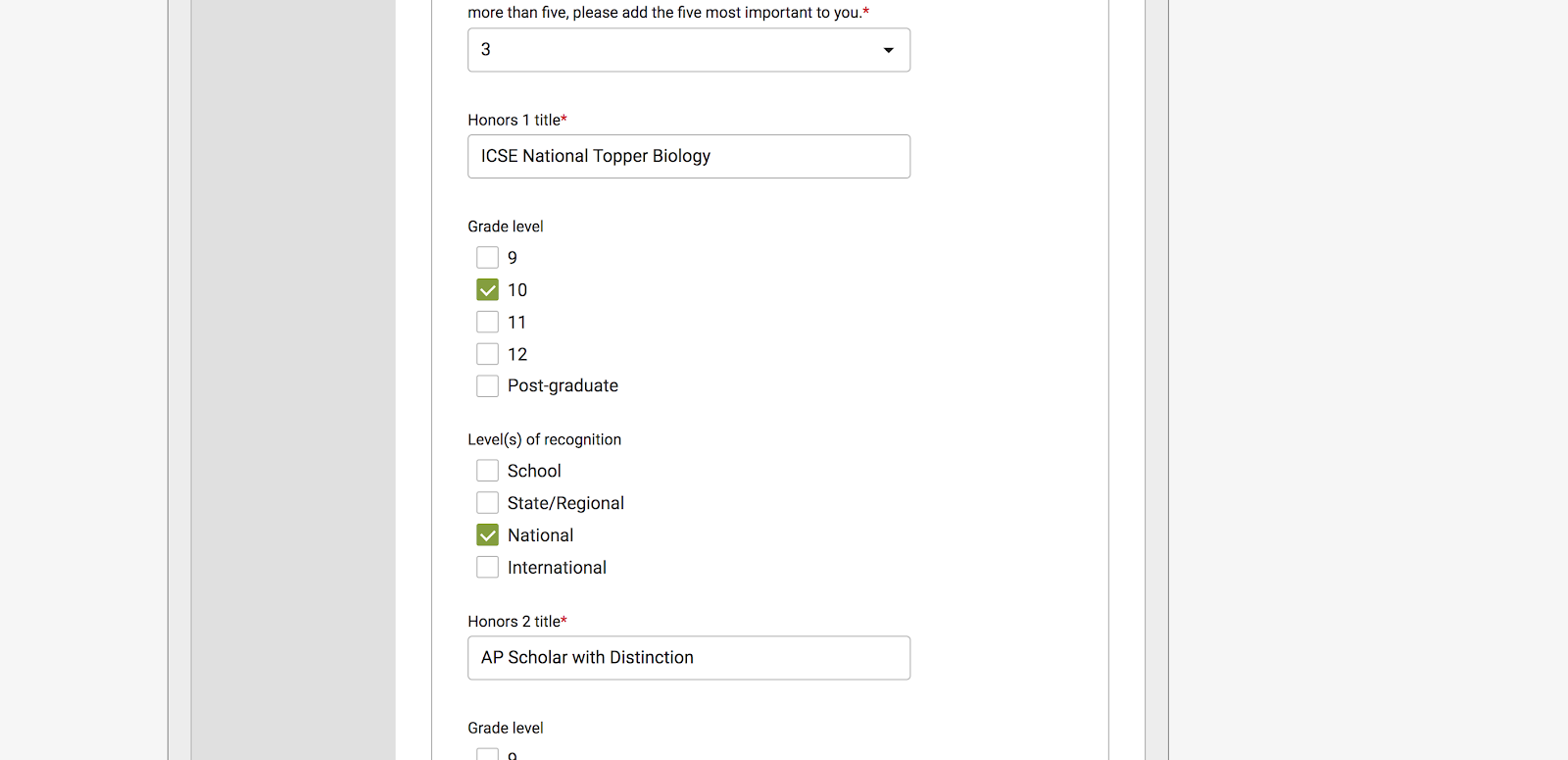

One of the most daunting parts about the college application process is actually filling out the Common Application. It’s a time-consuming process but is extremely important to do well. In this article, we’ll give you an overview of the Common Application section-by-section as well as provide insider tips and tricks on how to make the best of your application and help you get into your dream school.
What is the Common Application?
The Common Application is an integral part in applying to any US college. It’s an online application accepted by over 800 colleges that consists of sections to fill in personal, academic and extracurricular details as well as essays. The Common Application has its own essay, which is 650 words and is sent to every college that you apply to through the Common Application. You can apply to upto twenty colleges, however it’s important to be smart about which colleges and the number of colleges that you apply to because each college charges a fee of $65-$90 for every school that you apply to. The first step in applying to any college is creating a free Common Application account. This is a process that will take you less than two minutes to do.
Deciding Colleges
Now that you’ve created a Common Application account, it’s time to populate it with colleges. However, deciding colleges is hard. Hopefully by now you’ve researched and have some idea of which colleges you want to apply to. If you haven’t, here are some factors you want to consider researching to pick colleges:
Academic programmes and faculties (eg: presence/absence of business school, engineering school etc)
Overall reputation and reputation for the department you’re interested in and quality of faculty in these departments
Tuition
Academic system: quarter, semester etc
Campus culture: student organizations, presence/absence of Greek life, pre-professionalism, emphasis (eg: Stanford emphasizes tech)
Quality of Life Factors: Location, weather etc
After you’ve done your research and you have a broad list of colleges, it’s time to organize them into Dream, Target and Safety school. I would recommend organizing them into these categories by considering acceptance rate, median test scores and your ‘feel’ about where this school would fall into.
Dream School: Low Acceptance Rate, highest academic standards, your scores are around the 25th or 50th percentile of their accepted applicants. This is a number of schools that you aspire to but know that there is no guarantee
Target School: Your scores are around the 50th percentile of their accepted applicants. You believe that you could get into this school
Safety School: Your scores are in the 75th (or higher) percentile of their accepted applicants. It has a lower acceptance rate and you believe that your stats are higher than
Managing Colleges through the Common Application
When you sign up for a free Common Application account, you’re presented with a dashboard that has all the colleges that you are interested in applying to. Each college also has further information that talks about your completion status of different parts of your application. This is a good way to track the status of your application but I would also recommend using a digital calendar (you can use the AM College application calendar, which already has deadlines for the top 25 colleges uploaded) to track all the application deadlines, as they differ.
I would also recommend creating a Google Sheet or Excel Spreadsheet to serve as a college application tracking mastersheet. You should include the following columns: College Name, Plan Applying. Application Deadline, Supplement 1, Supplement 2, Scores Sent. I also added an additional Dream/Target/Safety column so that I knew how many of these schools I was applying to.
Although the Common Application dashboard has many of the same features, this spreadsheet will help you have all the details you need at a glance and is easily accessible and shareable on any device as well as customizable for my preferences.
You have to pick colleges from the My Colleges section. When picking colleges, make sure that you have at least two safety schools as well as 2-3 target schools and don’t apply to simply dream schools.
Personal Details Section
The next thing that you need to do is fill in the Personal Details section. This is an easy section to fill in as it just asks about personal details (name, birthdate, family, address etc) as well as demographic information. This is a good way to ease into the Common Application as it is the easiest section to fill out.
Education and Testing
Next comes the education and testing section. This is also a pretty simple section to fill out but there are some things to keep in mind:
Don’t fill in a class rank, even if you know what your class rank is, unless your school officially releases a rank list or puts it in your report card because universities do cross-check with schools
A semester system is where you have two terms (one that ends with half-yearlys and one that ends with finals). A trimester is where the year is split into three terms while a quarter is where the year is split into four terms. If you aren’t sure which one your school follows, make sure to check with your counsellor or principal
Academic Honors: You can choose up to five academic honors at the national, international and school levels. This includes anything from subject topper, academic excellence awards, standardized testing awards (Asset, NTSE), AP Scholar awards (awarded if you score more than 3 on three or more Advanced Placement tests). Unfortunately you cannot include additional details about the award so make sure that you make it as descriptive as possible when you are stating the name. The section looks something like this:

Community Programs: These include free scholarship programs that have helped you with your college application. This does not include school counselling, SAT coaching or a private counsellor, as those are not community-based organizations. An example of a community based organization is Super 30 for IIT coaching, so if you have any organization that you think provided similar support, enter it here.
Future Plans: By no means is this restrictive. You can enter absolutely anything you want, but I recommend keeping it close to your profile or the major that you are applying for. However, if you change your mind while applying, colleges are not going to evaluate you on it or hold it against you in any way.
Testing
This is where you can self-report all your test scores. Definitely self-report, because there are a number of schools that do not require you to send your scores through the College Board (which costs around $15 per score send). However, do not get tempted to change around your scores, even by 10 points. If they verify your scores in some way and they do not match, there are serious consequences and your offer of admission could be rescinded. You have the option to report multiple test scores so report as many of the tests you have taken. Many colleges follow the process of taking your highest section scores so submitting a number of different attempts may be beneficial to you. The application also has an option to put tests that you intend to take in the future or are currently taking, so definitely include all of those.
There is a question that asks about end of year exams and promotions. The answer to this question if you are following any Indian board, the IB curriculum or A Levels will be yes, as your promotion is contingent on your final results.
Hope you found my article on the basics of the Common Application useful. Feel free to post any questions about the Common Application on the Alma Matters Forum.
Good luck with your Applications!